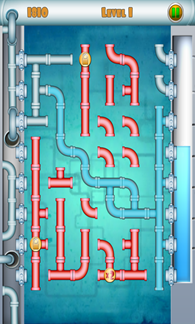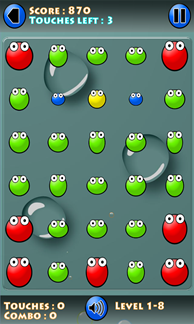Nicolas Sorel is CEO of Magma Mobile and a one-time .NET MVP and Windows Mobile developer. In November 2013, he and the company returned to Microsoft via Windows Phone and Unity, taking advantage of the easy app porting tools.
In only three months, Magma Mobile has ported 14 games to Windows Phone and accrued 2.5 million downloads. Porting a new game to Windows Phone each week, the French studio has indeed come full-circle. I recently caught up with Nicolas to learn about his path back to the Windows world and the strategies he has adopted to make his Windows Phone games so successful so quickly. Nicolas shares his story and strategies.
Nicolas Sorel (in white) with his team
What has led to your incredible success?
We succeed because we focus on gameplay and user experience. Beyond that, we’ve been in the right place at the right time; this is a great time to be on Windows Phone. Leveraging the Unity-Windows Phone collaboration, we’ve been able to easily port apps, developing for multiple platforms and reaching more users. Windows Phone’s strong platform allows developers to focus on what’s important: gameplay. Sales are encouraging, too. More and more people have Windows Phone devices. And, if Microsoft likes our game, they’ll highlight it in the Windows Phone Store. Having the Microsoft team behind our games has been our strongest asset.
You were a Microsoft MVP for several years. You then left Windows for Android. Now you’re back on Windows. Tell us more about your experiences.
I was a .NET MVP for six years. I’ve been a user and a fan since Windows Mobile began, and I always owned the latest Pocket PC. When it came to game development, though, I found limited opportunities compared to Android back in 2009. I continued to develop basic tools for Windows, but business-wise, my studio shifted to Android. Then in 2012, I discovered Unity 3D. I quickly saw the potential and especially loved the ability to deploy the same game on multiple platforms, including iOS. I quickly developed my first game on Unity, and we validated the Unity utility and then switched completely.
Now with Unity 4.2, we deploy our games on Windows Phone. The transition was easy, and business-wise, it is the right time to be on Windows Phone. We do very little to actively market the games on Windows Phone, and yet our extraordinary download rate means Windows Phone enjoys high user confidence. We’ve been so thrilled, we’ve released a game every week and plan to continue to do so for the next several months.
It’s definitely good to have you back and actively engaged on our platform. Tell us about the process of using Unity to port your games to Windows.
Unity makes porting fast and easy. I build my project with Unity and make adjustments in the Visual Studio project. We test our game on many devices, and if all is fine, I submit it to the store. For a .NET developer like me, it is easy to build our own plugins.
Tell us about your gameplay strategy and your most successful game(s) on Windows Phone.
Our most successful Windows Phone game, in terms of the number of downloads, is Burger (700,000 in 3 months), in which the player is “hired” by a chain restaurant to serve clients as quickly as possible in order to earn money and even tips. Players take orders from customers and manage their time effectively to advance to the next level; in each level, more ingredients appear on the menu. Plumber (602,000), Snakes and Apples (271,000), Smash (244,000), and Bowling 3D (156,000) are other Windows Phone titles whose download volumes hit record highs, just weeks after release.
We build “casual” or “waiting room” games. Our games require thought and offer many hours of play because they consist of hundreds, if not thousands, of levels. In Burger, players can advance through more than 300 levels and earn 40 different achievements. We wanted to create something casual yet engaging. Our best ideas come from everyone—developers and designers—and often when we least expect them; it’s part of the creative process.
Burger screenshot
Plumber screenshot
You said you do very little to market the game on Windows. Can you elaborate on the little that you do?
Burger Big Fernand edition
Partnerships and associations are central to our marketing strategy. For our game Burger, we partnered with Big Fernand, a French restaurant and a well-respected brand, to launch the Burger: Big Fernard Edition game. The partnership increased our marketing power since they helped us promote it. For example, Big Fernand’s Community Manager manages the Twitter and Facebook pages and builds social media awareness and excitement. For an upcoming game, Microsoft’s team in France is helping us promote the game through a Facebook campaign.
Bowling 3D screenshot
Why do you say that user experience is one of the foundations of your success?
Would you want to drive an old, worn-out car, even if it had a state-of-the-art Ferrari engine inside? I didn’t think so. All the time and talent in the world spent on the back-end won’t matter if the front-end isn’t fun to “drive.” When it comes to UX design, we aim for flawless. If, in 15 seconds, a new user isn’t convinced because he can’t find a feature or doesn’t know what or where to tap, you’ll lose him. To add insult to injury, you may get a one-star review because angry users are more eager to share their pain than happy users are to share their enjoyment.
What is your business model / monetization strategy? How did you arrive at the model you are currently using?
Ever since we began developing games, we’ve offered our games for free and have made money through in-app advertising and in-app purchase. Our primary goal is to get people to play our games, so we built our model around that goal, eliminating the barrier of a purchase price and making our in-app advertising as unobtrusive as possible: we never use full-screen ads that interrupt gameplay. User experience is paramount, even when it’s a question of money. Still, we display approximately two billion ads per month. We achieved this volume with careful planning from the outset so we could scale and earn enough to continue to develop new games. We continue to experiment with our monetization models; for an upcoming game, we are offering the first 20 levels for free and allow the user to unblock the next 400 levels via in-app purchase.
Bubble Blast 2 screenshot
Tell us about your target audience.
All our games are family-friendly and are available in many languages. Burger and Burger: Big Fernand Edition are available in 32 languages. We’ve translated other games into 20+ languages, including Arabic and Hebrew, but those are a little tricky. The majority of our users live in the US, France, Italy, Brazil, Russia, Japan, Argentina, and India. We’ve consciously localized to open new markets. For example, we initially had fewer users from Brazil and Russia. Now we have several million users from these geographies.
What’s the next big thing for you?
We published Bubble Blast® 3D just last week. It’s a sequel of our famous Bubble Blast®2 game, which has been downloaded 30+ million times on other platforms. I spent a lot of time and energy to make it even funnier and more engaging in 3D for Windows Phone users!
What is your advice to developers?
Timing is everything. Now is a great time to be a Windows Phone developer. The platform is versatile, and the opportunity for distribution is enormous. That’s why my studio and I came back in a big way. We are making the most of it, and I encourage you to do the same.
One of the best things you can do is to adopt a user’s perspective as you code your game; become a user and not just a developer who writes lovely code. Users don’t see and don’t care about your code; they just want to feel happy playing your game. Make your users happy.

![clip_image002[4] clip_image002[4]](http://blogs.windows.com/wp-content/uploads/sites/3/2014/03/clip_5F00_image0024_5F00_thumb_5F00_14135976.jpg)




